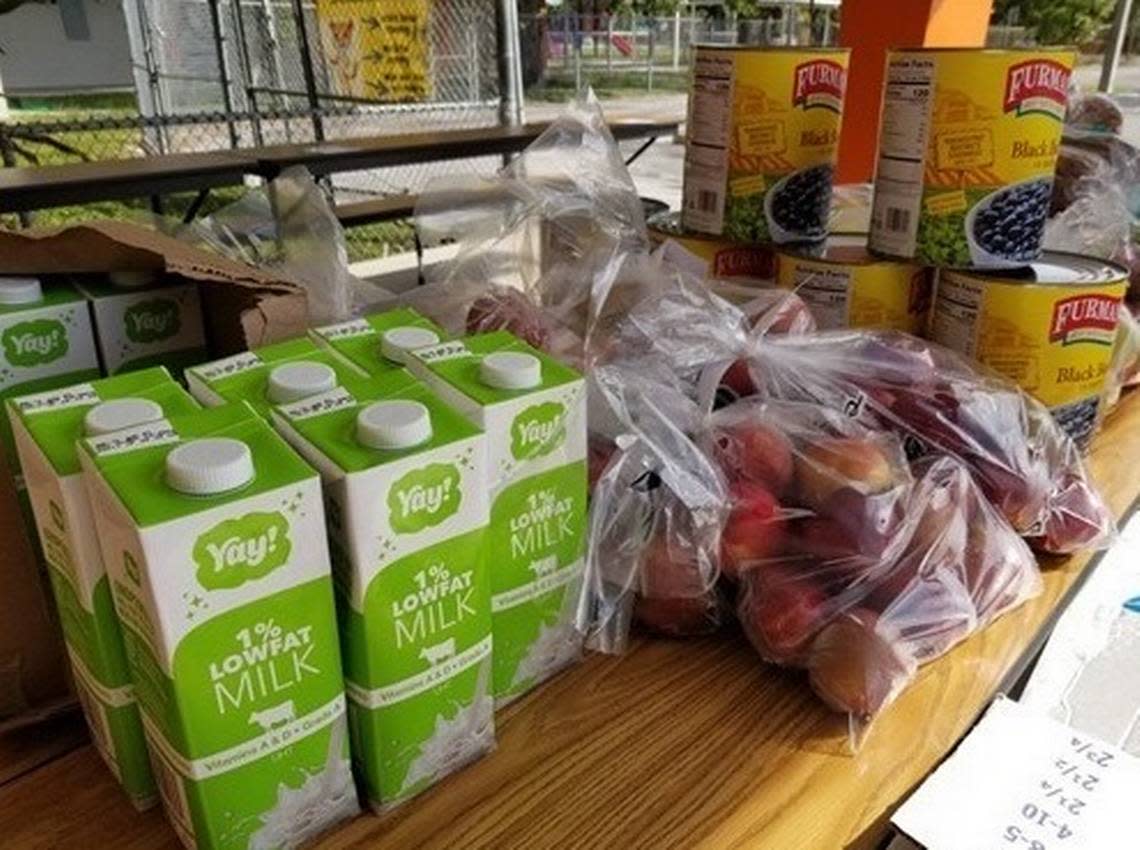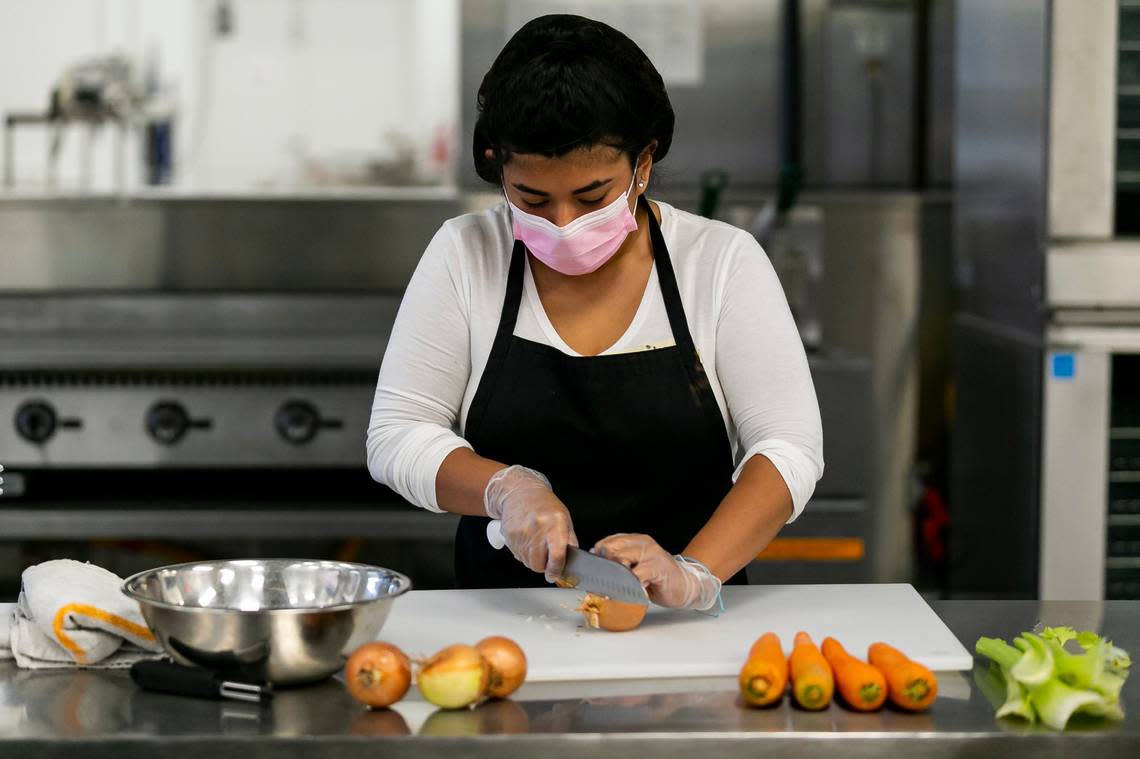Feeding South Florida, Miami-Dade school district are food lifelines for thousands
Nearly two years after COVID-19 vaccines were rolled out and businesses began reopening, food insecurity in Miami-Dade County remains nearly as exacerbated as it was at the height of the pandemic.
The high cost of food — and housing — in South Florida has led to a growing number of families facing food scarcity and food banks stretching to fill the gaps.
Food insecurity can mean a lack of nutritious food, or a lack of food altogether. And it doesn’t discriminate — anyone can become food insecure through financial hardship; the pandemic made that abundantly clear.
The Florida Department of Agriculture and Consumer Services reported in 2020 that 3.4 million Florida residents experienced food insecurity, including 1 million children. The numbers marked a drastic uptick from pre-pandemic 2018, where food insecurity impacted 2.5 million people statewide and 760,470 children.
Miami-Dade’s food insecurity issues
In Miami-Dade County, the numbers are actually worse: The county has a higher rate of food insecurity among adults and children than the state average.
“We are now seeing 1.1 million individuals coming into our warehouse or our pantries at our partner agencies not only the way they came during the middle of the pandemic, but more frequently because their dollars are not going as far as they used to, their federal benefits are not going as far as they used to,” said Paco Vélez, president of Feeding South Florida. “They’re having to ask for assistance more often than before.”
A lack of access to food is not a novel issue created by COVID, but it grew more acute with the economic downturn spawned by the virus. Businesses had to shutter their doors, millions of Floridians lost their jobs and it became difficult for many to know where their next meal might come from.
Though unemployment in Florida has sprung back to pre-pandemic levels as recently reported by the Bureau of Labor Statistics, food scarcity remains a prevalent issue.
“What we’ve all learned from the pandemic is that we have emotional needs, we have physical needs, and all of those things matter,” said Penny Parham, director of Miami-Dade County Public Schools’ Food and Nutrition Department. “Changes occurred during the pandemic that were able to break down any barriers that might have led to food insecurity in the past.”
What food insecurity looks like in Miami-Dade
Census data shows that 15 percent of the more than 2.5 million people in Miami-Dade County experience poverty.
Miami Matters, a Health Council of South Florida initiative, releases data on food insecurity across the county each year. The most recent data estimates the county’s food insecurity rate is 10.8 percent, and the child food insecurity rate is 18.2 percent — both higher than the statewide average of 10.6 percent and 15.7 percent, respectively.
According to Feeding America, the largest hunger-relief nonprofit in the country, food insecurity is associated with “delayed development in young children; risk of chronic illnesses like asthma and anemia; and behavioral problems like hyperactivity, anxiety and aggression in school-age children.”
And in adults, the United States Department of Health and Human Services reports a higher risk of obesity and chronic disease associated with food insecurity.
Here’s a look at what two groups — Feeding South Florida and Miami-Dade public schools — are doing to help feed people in Miami-Dade County:
Feeding South Florida
Paco Vélez said he believes he found his way to food banking through fate. The former Texan began working with food banks when he accepted a job offer in San Antonio fresh out of college. He had studied to become a doctor or forensic scientist, but stumbled across food banking by chance and chose to stick with it. The line of work is what prompted his move to Florida, where he became the president of Feeding South Florida 10 years ago.
Feeding South Florida is a member organization of the Feeding America network. It services Palm Beach, Broward, Miami-Dade and Monroe counties, more than 25 percent of the state’s food insecure population. Vélez said the past few years have proved especially challenging for the nonprofit.
Ordinarily, Feeding South Florida feeds about 700,000 individuals a year, Vélez said. During the pandemic, that number skyrocketed to 1.5 million. And even now, it still hovers over 1 million.
“Over the past couple of years, Feeding South Florida has seen food insecurity rise to levels not seen before, but isn’t always indicative of the magnitude of what a family can experience,” Vélez said.
Through 2019 and 2020, Vélez and his team worked in overdrive. They created about 40 drive-through distribution centers to ensure families could still access boxed donations. Shifts were extended from five days a week to six, from two shifts a day to three.

Over the past year, Feeding South Florida was able to go back to its pantry system. Now, across 232 pantries and participating locations, South Floridians can enter a food pantry and select from a broad range of items.
Feeding South Florida also offers a warehouse training program and culinary training program to help residents gain skills to land jobs in food service. And the organization offers application assistance for families seeking federal benefits like SNAP food stamps or Medicaid.

“We really wrap services around the food to ensure families don’t just have the food but they have other support around them to help them move to a place of self sufficiency,” Vélez said. “We help families navigate the application process.”
Feeding South Florida employs 92 people and enlists help from more than 30,000 volunteers. It has the largest retail program in the Feeding America network across the country.
In 2021, Feeding South Florida received more than 20 million pounds of food provided by partnering retail agencies and more than 44 million pounds provided by farms across the state.
“On any given day, Feeding South Florida has less than a week’s worth of food in inventory,” Vélez said. “Without continued support from our partners and community, Feeding South Florida would distribute all our food in six days.”
Miami-Dade school district extends free meals
For children who experience food insecurity, the pandemic brought greater challenges.
Students who received free or reduced lunch at schools fell at risk of not accessing those meals with campus closures. And in Miami-Dade County, where Miami Matters estimates the food insecurity rate for children is more than 3 percentage points higher than the statewide average, plenty of children fell subject to said risk.
“We’ve typically had as a district about 73 or 74% of the students enrolled in Miami-Dade who were eligible for free or reduced price lunch,” said Parham, the district’s director of the food and nutrition department. “The percentage is still about the same.”
Like Feeding South Florida, Miami-Dade County Public Schools had to improvise. From March 2020 to August 2021 — at the height of the pandemic — 38 million meals were distributed to families through drive-by pickups stationed at schools across the county. The ingredients were already accounted for under the National School Lunch Program, and rather than waste it, the district worked to cook and distribute every morsel it could.
The meals included everything from fresh bread baked at Bread and Bread bakery in Doral, shelf stable milk, yogurt, frozen pizzas, ground beef, fruit and vegetables.

The pandemic is also what prompted the school district to begin offering free breakfast and lunch to all of its more than 300,000 students. The Community Eligibility Provision is a nationwide program that offers eligible schools an opportunity to provide the two free meals a day. A school is deemed eligible for the provision if at least 40 percent of the students qualify for free or reduced lunch, a qualification made on the amount of household income.
“Maybe your family is fine and you’ve got plenty of food, but maybe you went out the door that day and you forgot to bring your lunch or you forgot your money in your account. Now the access is the same for every child. And so every student has the same access to a healthy meal because they all deserve to be able to go through their day and not be hungry.”
Now that the school district has qualified for the Community Eligibility Provision at every one of its 392 schools, the free meals will be offered for up to four years, until schools reapply for eligibility.
“We’re providing everyone, all of our students, meals at no charge, and if there’s no issues, it’ll be in place for the next four years,” Parham said. “There might have been students who came to school and didn’t have a free lunch approval or maybe they fell through the cracks. That’s gone.”
